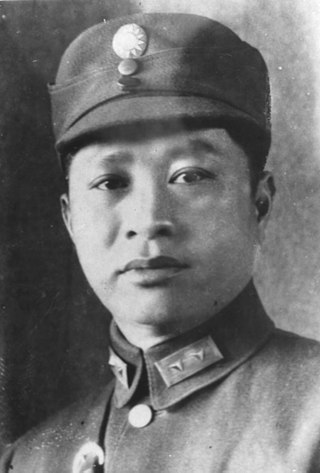
Ye Ting, born in Huiyang, Guangdong, was a Chinese military leader who played a key role in the Northern Expedition to reunify China after the 1911 Revolution. After serving with the Kuomintang, Ye later joined the Communist Party of China (CPC).

Jingchuan County is county under jurisdiction of the prefecture-level city of Pingliang, in the east of Gansu Province, China, bordering Shaanxi Province to the southeast. It has a land area of 1,486 square kilometers. The county is named after the Jing River. In 2020 it had a population of 356,200, over 300,000 of whom in the rural area.

Gangu County is a county in the southeast of Gansu province, the People's Republic of China. It is under the administration of Tianshui City and is the most populous county in Gansu. Its postal code is 741200, and in 1999 its population was 570,318 people.

Ning County or Ningxian is a county in the east of Gansu province, China. It is under the administration of the prefecture-level city of Qingyang. Its postal code is 745200, and its population in 1999 was 505,660 people.
Lingtai County is a county in the southeast of Gansu province, China, bordering Shaanxi province to the south and east. It is under the administration of Pingliang City. Its postal code is 744400, and in 1999 its population was 226,576 people. It was first established in 605 AD.
Bikou Town (碧口镇) is a town under Wen County, in Longnan, Gansu. It is located along the Bailong River, just downstream of the Bikou Dam. In 2008 it had a population of 16,901.
The Hani languages are a group of closely related but distinct languages of the Loloish (Yi) branch of the Tibeto-Burman linguistic group. They are also referred to as the Hanoid languages by Lama (2012) and as the Akoid languages by Bradley (2007).
The Angkuic languages are spoken in Yunnan province, China and Shan State, Burma.
Duota is a Southern Loloish language of Yunnan, China. Duota is spoken in Jiangcheng Hani and Yi Autonomous County, Xinping Yi and Dai Autonomous County, and Yuanjiang Hani, Yi and Dai Autonomous County.
Angluo is a Southern Loloish language of Yunnan, China. Angluo is spoken in Jinping Miao, Yao, and Dai Autonomous County and Yuanyang County, Yunnan.
Guohe is a Southern Loloish language of Yunnan, China. It is spoken in Dengqu Village 登去村, Majie Township 马街乡, Yuanjiang County 元阳县, Yunnan. It is known as Guohong 郭宏 in Yuanyang County, Yunnan.
Shehua is an unclassified Sinitic language spoken by the She people of Southeastern China. It is also called Shanha, San-hak (山哈) or Shanhahua (山哈话). Shehua speakers are located mainly in Fujian and Zhejiang provinces of Southeastern China, with smaller numbers of speakers in a few locations of Jiangxi, Guangdong and Anhui provinces.

Guyaju Caves (古崖居) are the ruins of a cave complex that may have served as dwellings for a fortified community situated in a valley near present-day Dongmenying, Yanqing District, Beijing, China.

Taizi Changqin or Prince Changqin is a deity in Chinese religion. He is the only son of the fire god Zhurong and was the first musician in the Three Realms. He appears in the Classic of Mountains and Seas and Commentary of Zuo.
Guochengyi is a town of Huining County, Gansu, China. It consists of 11 administrative villages and 59 natural villages.
Ankou is a town of Huating County, Pingliang City, Gansu, China. The town is highly industrialized.
Chaona is a town of Lingtai County, Pingliang, Gansu, China. The town was historically known as Dongchaona (东朝那) and Anding Chaona (安定朝那). It is the birthplace of Huangfu Mi. During the Western Wei it was the seat of Anwu County and Chaona County, where it served as a resource distribution center and military base.
Shifo is a town of Maiji District, Tianshui, Gansu, China. Its history can be traced back to at least 937.
Koutouba is a township of Wen County, Gansu, China. It was formerly known as Changnan township, which was created by merging Dujia and Changbei Township.







